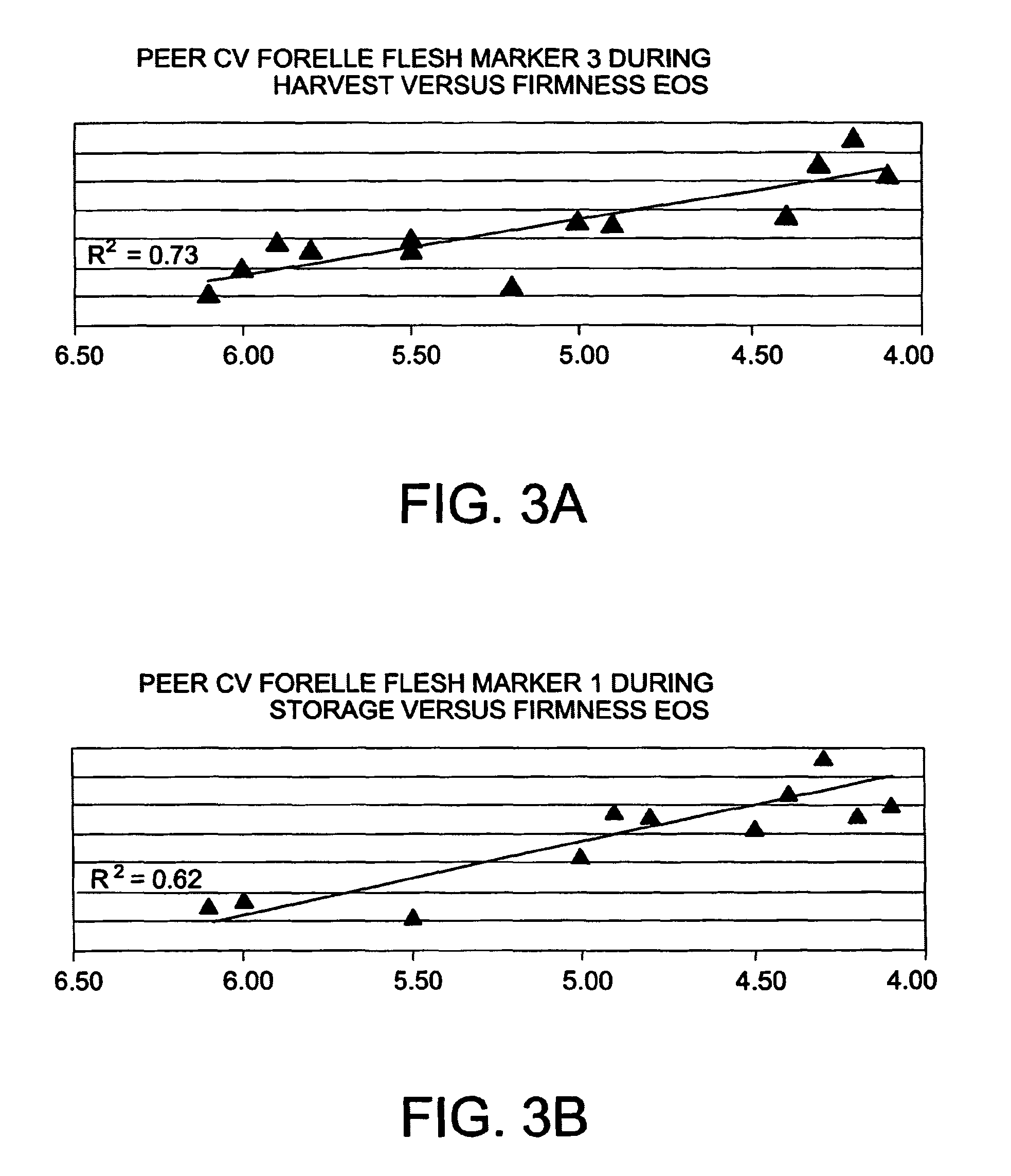Determination of quality features in agricultural and horticultural crops
a technology for quality features and agricultural crops, applied in the direction of instruments, immunoglobulins, peptides, etc., can solve the problems of not necessarily the most optimal value in another situation, difficult to quantify, and no harvest window optimal,
- Summary
- Abstract
- Description
- Claims
- Application Information
AI Technical Summary
Benefits of technology
Problems solved by technology
Method used
Image
Examples
example 1
Determination of Correlation of Gene Expression and Fruit Ripening in a Number of Varieties of Apple and Pear
[0070]Data were collected at various orchards for two pear cultivars, Bon Chretien and Forelle and two apple cultivars, Golden Delicious and Granny Smith. These 4 cultivars were harvested in South Africa for the South African situation (harvest, short storage, conditioned transport to markets such as Europe). Right after harvest (within 48 hours) the value of the various markers was determined in the flesh. For this purpose, mRNA was isolated from a mixed sample of fruits using a CTAB protocol (Plant Molecular Biology Reporter Vol. 11(2), 1993, pp. 113-116). The various markers were identified via the earlier-mentioned techniques of expression profiling and validated via RT-PCR. Use was made of the following primer sets to test all samples:
[0071]
Forward PrimerReverse PrimerPGGCCCTAATACGGACGGAATTCAATACAGTCATCACCTGTTCCTATAACCβXYLAACTAATTGGTGCTGCTGAGGTTGTCCGGTCTCTGAACTCTGCTT424 / ...
example 2
Determination of the Optimal Time of Lifting Tulips by Correlation with Flowering Quality after Harvest with Gene Expression Around the Time of Harvest
[0080]During a period of four years, three tulip cultivars, cv ‘Apeldoorn’, cv ‘Leen van de Mark’ and cv ‘Prominence’, were each time sampled on the same growing lots. Sampling was carried out at different times in the season, from 6 to 7 weeks before the expected date of lifting with an interval of 2 weeks, at least 1 week before the established lifting date, at the moment of lifting, and a week after. The growing lots were each time sampled in the morning, after which during the rest of the day sample processing took place. From the outermost bulb scale, a piece of tissue of a size of 1 cm2 was taken, which was fixed in liquid nitrogen immediately. Next, in this tissue, the gene expression was determined of a sizeable number of genes on the basis of which 3 markers were identified that have a relation with the time of harvest during...
example 3
Determination of Correlation of Gene Expression and Quality of Rose Cut Flowers
[0090]Gene expression data were used to predict the vase life of rose. In practice, it appears that some roses keep well on the vase at the consumer for only 5 days whereas other roses (of the same cultivar) sometimes keep well for as many as 10 days. This is often due to their being harvested while too unripe, which compromises quality.
[0091]It was investigated of which gene or which genes the expression exhibits a good correlation with the time of harvest and quality. With the gene expression data, using the earlier-mentioned techniques, a correlation was carried out with the vase life of the rose. Determining the relative expression in flower petals during and after harvest enabled making a prediction about the expected vase life of the rose. The gene found to be useful for this purpose is a GDSL-motif lipase in combination with a constitutive marker, in this case elongation factor 1α, see FIG. 12. Als...
PUM
| Property | Measurement | Unit |
|---|---|---|
| temperature | aaaaa | aaaaa |
| temperature | aaaaa | aaaaa |
| temperature | aaaaa | aaaaa |
Abstract
Description
Claims
Application Information
 Login to View More
Login to View More - R&D
- Intellectual Property
- Life Sciences
- Materials
- Tech Scout
- Unparalleled Data Quality
- Higher Quality Content
- 60% Fewer Hallucinations
Browse by: Latest US Patents, China's latest patents, Technical Efficacy Thesaurus, Application Domain, Technology Topic, Popular Technical Reports.
© 2025 PatSnap. All rights reserved.Legal|Privacy policy|Modern Slavery Act Transparency Statement|Sitemap|About US| Contact US: help@patsnap.com



